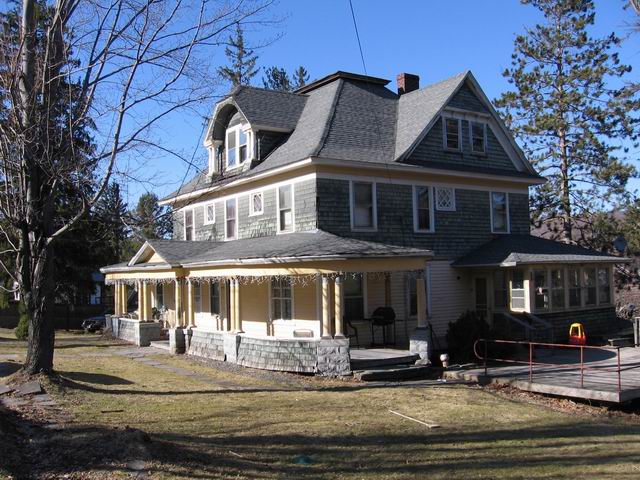DuBois Street Houses
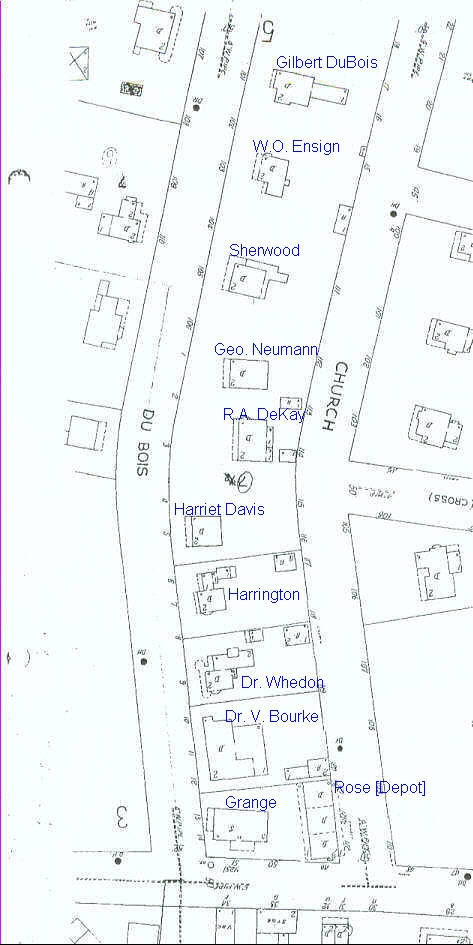
Included is the Sanborn map, dated 1924, showing the DuBois Street area. I've included the names of the residents who lived there in 1915. The structures were the same ten years later (in fact, they are still pretty much the same almost one hundred years later) except for the Whedon house which did not exist then. The lot that the Whedon house was on was part of Dr. Bourke's lot in 1915.
Fred
<click pictures for full size>
Dr. DeKay came to the Manor as a young physician in 1889, sharing medical duties in the community with Dr. G.H. Lathrop and came to have a large practice. His residence, along with his office, was on DuBois Street, just a few houses up from the intersection with Main Street. On the evening of May 3rd, 1910, William O. Ensign, the editor of the local newspaper and who lived only a short distance away, paid a visit upon Dr. DeKay. When Ensign received no response to his calling, he entered the house and found the doctor laying on the couch of his office, all the appearances of a sudden death. His rather young age of 49 made the news of his demise a shock to the community.
Today, the house still stands on DuBois Street. Over the past years, various mysterious incidents have transpired at the house, causing wonderment both to the house's residents and neighbors as to their origins. To them it is called, rather jokingly, as "The Ghost House," though none of them know the true history of the structure. I myself have witnessed one such episode.
Dr. Richard DeKay House - "The Ghost House"
<click for full-size>
For Dr. DeKay, his death was officially attributed to acute bronchitis, and
occurred only a few days after his mother also experienced a sudden death.
Perhaps the message that "The Ghost House" incidents are suggesting is that
his death, and maybe his
mother's also, were not quite so innocent.
Dr. Richard DeKay located to Livingston Manor immediately
after finishing his medical training in 1889 and within a year began his
medical practice. Two years later he married Nellie LeRoy, a girl from
Hurleyville. Like the wives of most of the prominent businessmen and
prominent citizens of the community, Nellie became involved in local civic
affairs, especially the Presbyterian Church where, because of her musical
training and talent, became the organist for the church. This church has
long prided itself on its musical talent among its parishioners, a tradition
that continues to this day, with fund-raising recitals and entertainments
being very popular in the community. Besides performing with the ladies
chorus group and church choir, Nellie also performed piano solos and duets
at many of these events.
Dr. Dekay's practice florished and in a day when doctor's house calls were
the norm, Dr. DeKay would travel from Willowemoc to Lew Beach, from Dahlia
to Shandelee, perhaps the largest territory travelled by any of the local
visiting doctors. These home visits were often among those who could least
afford medical care, and to those he often failed to put a price on his
services.
Nellie, who was in charge of his bookkeeping, was well aware of his
benevolence, and apparently did not share in his medical charity. Within two
weeks of Dr. Dekay's death, hardly time for the body to cool off in his
casket, Nellie advertised in the Livingston Manor Times the following
notice;
"All persons indebted to the estate of the late Dr. R.A. DeKay will find an
opportunity to pay at the office on the following dates; July 7th and 8th,
21st and 22nd, August 4th and 5th, 18th and 19th, and September 1st and 2nd.
- Mrs. R.A. DeKay"
One can only imagine the willingness of the sickly to ante-up to the dead
doctor, who would no longer serve them and was no longer in need of their
payments.
As W.O. Ensign was returning home from his
newspaper office during the evening of Tuesday, May 3, 1910, he came upon a
commotion that was stirring on DuBois Street.
The previous weekend, the Dekay family, the Doctor, his wife Nellie and
eleven year old son, Garrett, traveled by rail to Middletown and Port Jervis
to visit her relatives. On Monday, Dr. DeKay left his family behind at Port
Jervis and returned home on the evening train, retiring to his residence's
office upon his arrival.
Matilda Sherwood, their neighbor, was used by the DeKays to assist them in
the domestic chores about the house. Upon her arrival the next morning, she
noticed that Dr. Dekay was in his office, with the door locked, and
apparently resting on the office couch. Since she was instructed never to
disturb the Doctor except in an emergency, she went about her daily chores
for the rest of the day. Late in the day, she felt that the Doctor should be
awakened, but her efforts to arouse him failed. Being alarmed, she went to
the Davis house next door just when Ensign was walking by. Ensign, who
happened to have a key to DeKay's office door, retrieved the key and
returned to let himself and the neighbors into the office, only to find Dr.
DeKay had slept his final sleep.
Dr. Richard DeKay was not the only physician in his family. His older
brother, William H. DeKay had a medical practice in Parksville which was
taken over by Richard. William then set up a highly successful practice at
Hurleyville, eventually becoming the county coroner and was called to
confirm the death of his younger brother. Though there was evidence of the
Doctor overdosing on medicine (he was, at the time, under the weather with a
cold), his brother signed the death certificate that acute bronchitis as
being the cause of death.
The official cause of death had been documented, but it failed to cease the
rumor mill. If it was an overdose of medicine, was it
accidental? Or were their other motives in the Doctor's action?
Fred
It was generally reported by the local newspaper that W.O. Ensign was the first to discover Dr. R.A. Dekay as the doctor reposed in death's slumber on his office couch. Though the reading public believed these initial reports, those closer to the event would eventually prove that rumor can be more reliable than the printed word.
William
O. Ensign House
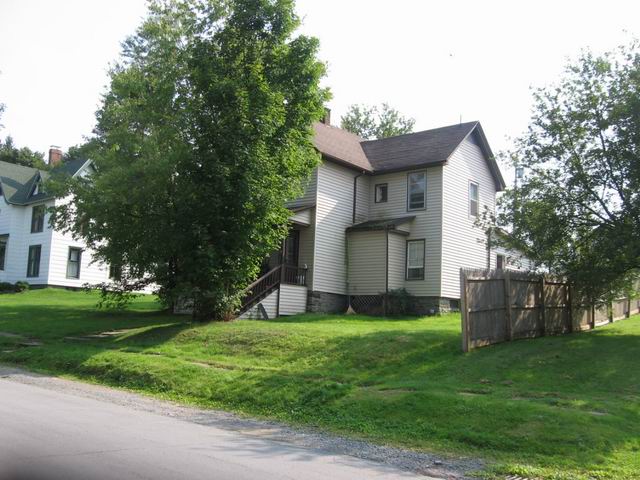
William Ogden Ensign was a neighbor to the DeKays, living three houses up
the street. Ensign, whose family hailed from Hancock, came to the Manor in
1890 and, with his brother Frank, acquired the local newspaper from its
publisher, Eli Starr. His brother would not remain long with the printing
business, for a different calling was beckoning him to the Montana Rockies.
William stayed and made the newspaper, which had a hand-press that could
produce but thirty copies an hour and with a subscription of a little over
100, into one of the most read papers in the county. The front page of "The
Ensign", as it was then called, was filled with news from all around the
county, burying local tidbits and local correspondents columns to the inner
pages. The countywide-news format proved successful; the subscription rate
for The Ensign increased dramatically and by upgrading his equipment, his
press could now turn out over 1000 copies per hour.
W.O. Ensign's interest in the newspaper business was overshadowed when
letters sent back home from Frank informed William that he had supposedly
struck gold. Beginning in 1905, W.O. Ensign made many journeys to the
prospecting fields, leaving his newspaper, as well as his family, in charge
of his wife, Jeanne Dodge Ensign, for periods of months during these
excursions.
The Ensign and DeKay families moved to the Manor about the
same year, either 1889 or 1890. William and Jennie Ensign had already a
young family, with one infant daughter, Fannie, two years of age. The
families became close friends, sharing in many social engagements. The young
physician became the Ensign family doctor, delivering the Ensigns' next
daughter, Martha, in 1893. DeKay delivered the Ensign's third daughter,
Helen, in 1899 while his own wife, Nellie, was soon to give birth herself.
Garrett DeKay was born only a few months later in 1900. This was the Dekays
second attempt at starting a family, a daughter dying tragically, it is
assumed, as a newborn in 1898.
After the Doctor died, Nellie and Garrett stayed at the DeKay residence on
DuBois Street. With her talent and training in the
music field, Nellie taught music and gave piano lessons at the home. This
successful endeavor produced two noteworthy students; Mildred Hull, daughter
of bookkeeper C.B.N. Hull, the finest vocalist in the Manor during her era,
who went to pursue an education in music but whose life was cut tragically
short by tuberculosis, and Nellie's son, Garret.
Nellie was a charter member of the Livingston Manor chapter of the Order of
Eastern Star, formed in 1903, and after her husbands death, became the
district deputy of the Sullivan Delaware District. She devoted herself to
this work, traveling throughout the district in this role.
fred
Nellie DeKay and Jennie Ensign, DuBois Street neighbors,
after Dr. Richard DeKay's untimely death, were now both in a similar
situation; both left to themselves to raise their families. With her musical
background, Nellie now taught music full time to both young and old alike,
her class numbering up to twenty pupils. Her son, Garrett, was also
musically gifted and Nellie pursued all options for him to expand that
talent. During the summer of 1915, she and Garrett, who was now 15 years of
age, removed to Asbury Park, New Jersey, so he could play with the summer
orchestra there, an accomplishment for one so young. The next year, she
advanced him beyond what she or the local school high school could offer and
enrolled him in the New York Military Academy at Cornwall, New York.
Jennie's family circumstances were different, but resulted in a somewhat
similar situation. Her husband seems to have tired of the newspaper
business, being both editor and publisher, and by 1912 hired A.L. Sherman to
take over as editor to the local paper. Freeing himself from the daily
operation of the Livingston Manor Times, Ensign made himself scarce in the
local community, apparently retreating to his brother's mines at Colorado,
leaving Jennie and daughters Helen and Martha behind. Martha Ensign soon
married Charles Benton, son of the Livingston Manor feed merchant E.L.
Benton, and when they set up housekeeping, Jennie moved in with them,
renting out the Ensign house to Harold Forbes, who eventually bought the
newspaper from W.O.Ensign.
It was of little surprise to the Manor community when they read the
following news item;
"By a decree of the Montana Courts, entered December 17, 1916, W.O. Ensign,
former editor and publisher of the Livingston Manor Times, and Jennie D.
Ensign were divorced. The cause for the divorce, as stated in the action,
was desertion."
Throughout the winter and early spring of 1917, Nellie DeKay remained
involved with her local musical obligations, still holding classes and
playing piano for the choir and organ at the Presbyterian Church. In March,
though, she abruptly resigned from all these endeavors. The community was
shocked when the following article appeared;
"Announcements were received in Livingston Manor Thursday morning of the
marriage of Mrs. Nellie L. DeKay and Mr. William Ogden Ensign, at Livingston
Manor, on Saturday, May 12, 1917."
Hariett Davis House
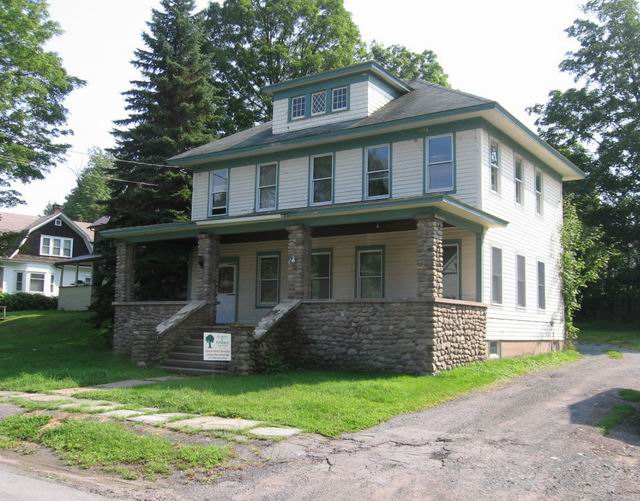
Matilda Sherwood House
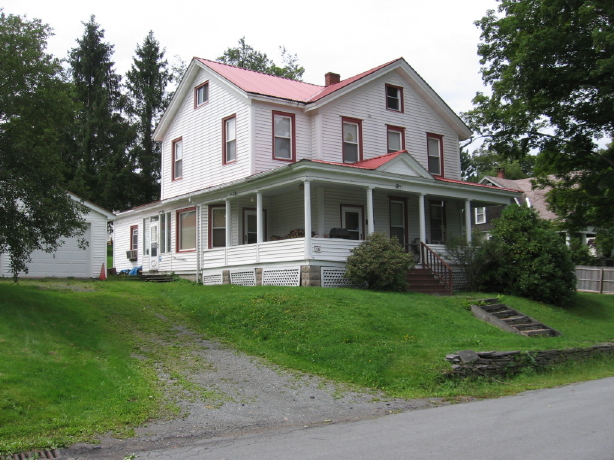
Matilda Sherwood was the adopted daughter of Charlotte Sherwood and the house was given to her by Charlotte's will when she died in 1905, much to the chagrin of Tillie's foster-brothers, Webster and Stephen Hanford Sherwood.
George
F. Neuman House
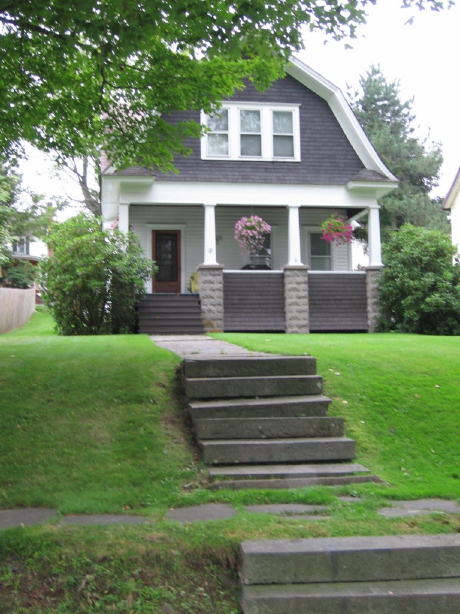
Now without the income generated by her husband's medical
practice, Nellie DeKay sold a portion of her spacious lot on DuBois Street
to George F. Neumann in 1914, who built the attractive house next door and
was moved in within a year.
The Neumann family hailed from Callicoon Center. The father, George Henry
Neumann, had a background in hostelry, both at Callicoon Center and New York
City, and plied the trade of butcher. In 1899, the family moved to
Livingston Manor, with George H. operating a meat wagon before establishing
a market out of the Bussey building at the corner of Main and River streets.
He eventually became the proprietor of two of the Manor's hotel, The
Arlington and later, The Hotel Main, the latter located in the center of the
growing Manor community.
George F. Neumann further developed his father's property by adding an
amusement hall in back and a building next door, which housed a restaurant,
billiard room and bowling alley.
"Geo. F. Neumann is grading the lawn and laying stone steps
and approach to his new home on DuBois Street. T. and J. Neild are doing the
work."
April 29, 1915
Livingston Manor Times
Fred
Gilbert DuBois House
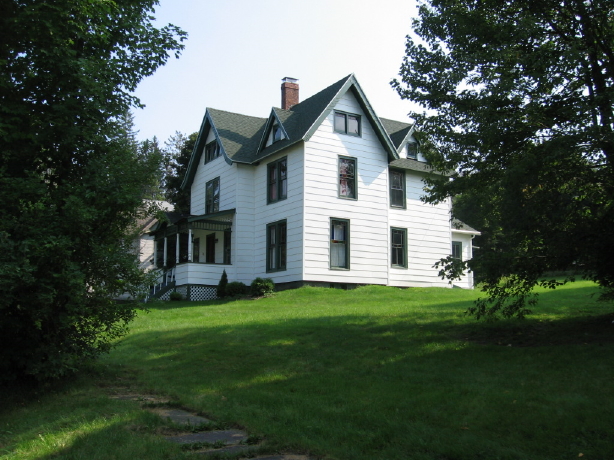
My interest in this house began when I was working at the house and noticed
the name of "Gilbert DuBois" inscribed on the basement windows. Apparently
they were ordered from the lumber yard for Mr. DuBois, either when the house
was built or some later renovation on the structure during his lifetime.
Gilbert DuBois was a brother of Alvin Preston DuBois and one of the partners
of the firm "A.P. DuBois & Company". Though he originally had charge of the
books, he was involved in selling wagons and their apparatus and later
managed the furniture division of the firm. C.B.N. Hull would eventually
become the full time bookkeeper to the firm. When the firm dissolved around
the early twenties, Gilbert began a furniture business which he operated for
a short time before ill health came upon him.
The stress of the business must have been burdensome for both men, Hull and
DuBois, for both were afflicted with nervous disorders, Gilbert finally
having to be institutionalized at Middletown where he is thought to have
committed suicide in 1926.
The Gilbert DuBois house was erected in the summer of 1888. If those
basement windows were part of the original construction, that would put
their age at 120 years. I would suspect that they are not original, though,
as basement windows are often early beaten by the weather, but with
Gilbert's name upon them, they would still need to be over 80 years old.
fred
You are right that there is an inscription in the upstairs
bedroom. It says "Papered by RJ Kay May 6, 06". It seems that the room has
wall paper that was put up in 1906. When I bought the house I was told that
there had been an cabinet on the wall that seemed to have been there forever.
When it was taken down, the wall paper came off too and the inscription was
revealed. When we repainted the wall, I left a frame of space, which
includes the inscription and a part of the old wall-paper. I then covered it
in sealant so it would remain visible and not decay.
I also discovered a bullet molding that had been removed during the
renovation that was started just before I bought the house. It has the name
of the architect, in Ellenville and the date of construction for Gilbert
Dubois. I have not seen the window frames in the basement but will take a
look at them soon.
Ilene
The inscription found behind the peeling wall-paper on the walls of the
Gilbert DuBois house, which reads "Papered R.J. Kay 1906", is probably the
signature of Robert Kay, well-known paper-hanger and painting craftsman
during his day. The Kay family formed a partnership known as "C.A. Kay &
Company" and began a mercantile business in 1890 located at the center of
town, their store known as "The Center of Town Store", which would later
become the feed store of Johnston & Fitzgerald. The relationship of Charles
Kay and Robert Kay, whether as father and son, or as brothers, is not known.
With the demise of the foundry business at Livingston Manor, which was
located at Jacktown, because of the untimely death of its proprietor,
Lafayette Gilbert, in 1895 and the building's fiery destruction in 1897,
Robert Kay began the erection of a new foundry in the early spring of 1898,
probably at Rock Avenue, which was completed that June. This is also the
same year that Thomas Dawson began the construction of his foundry building,
across the street from Alonzo Ostrom's blacksmith shop on Main Street, which
was not completed until later that fall. The Dawson endeavor would prove to
be the more succussful of the two businesses.
"The "Center of Town Store" is being treated to a coat of paint. Charlie and
Robert Kay are the artists."
August 17, 1899
Roscoe-Rockland Review
Fred
Not all of the historical "paperwork" that Ilene mentions
concerning the DuBois house is of the 8 x 11 variety. Besides the "Gilbert
DuBois" inscription on the basement windows, there is a notation on the wall
in a bedroom on the second floor, the area apparently never to have been
painted over by any of the inhabitants and is covered with a picture. The
name, which escapes me for I didn't jot it down, is that of a local
plasterer. Perhaps Ilene can share this with us.
fred
The firm of C.A. Kay & Company, James A. Kay and Charles
H. Kay, opened its doors to the mercantile buisness of "The Center of Town
Store" in 1890. Its location was considered advantageous to the new
proprietors, being situated at the corner of Church Street, which led up to
the Methodist Church and many recently built residences there, and Main
Street, the newly opened route that was laid out upon the Sherwood lot that
already had the successful businesses of Alonzo Ostrom's blacksmith shop,
Frank Yonker's harness shop and the recently built hotel of Robert Bloomer,
which provided spirits to both the traveling and non-traveling public.
The Kays remained in business until 1900, when they sold the store to the
firm of Johnston & Fitzgerald. William G. Johnston and David Fitzgerald
formed a partnership in 1893, opening a mercantile and feed business at the
Masonic Hall, sharing space on the ground floor with William Ensign's
newspaper. James Kay and Charles Kay both removed to Pennsylvania.
Fred
"R.J. Kay of Brooklyn was in town last week at which
time he purchased from James Murdock the property known as the Grange
building. The purchase price was said to be over $4,000."
May 10, 1910
Liberty Register
Fred
The wife of Gilbert DuBois is also from a Manor family of
note. Emily DuBois was the daughter of Rev. Henry A. Harlow, generally
credited to be the first minister of the Presbyterian Church at Livingston
Manor, which was formed in 1880 and the church building completed early in
1881.
Young Harlow began his ministry duties in 1875 at the Town of Rockland,
preaching at the Westfield Flats [Rockland] and Shin Creek [Lew Beach]
Presbyterian churches. His official duties at the Manor church were
confirmed in 1883, and during the five years that he served this
congregation, the membership grew from 24 to 72, and he united 27 couples in
marriage and conducted 32 funeral services. He eventually removed to
Monticello, taking charge of the Presbyterian church there, but was a
frequent visitor back to the Manor, visiting his daughter as well as his
in-laws, the Hammonds of DeBruce.
Emily DuBois, as you can imagine, had a strong religious background and was
very active within the church and its various related
organizations. She kept the house after her husband's death, but in her
older years wintered with her daughter in New Jersey until her death in
December of 1940. The house was then quickly sold to Delos Barker.
Fred
Anybody ever hear of an Olive DuBois connected with
Gilbert in any way? Dau? Sis? cousin? anything?
Harriett
Gilbert had three daughters, who were surviving at the time of his death;
Edith, Dorothy and Emily. There were also at least three
sisters; Mary, Antoinette and Katherine.
fred
The Connollys bought the DuBois house from Delos Barker in
1947. The father, son and daughter resided on a farm up at the Little
Ireland section before the move down to their new Dubois Street home. Most
Manorites, at least those who consider themselves as old-timers, which many
of us are quickly becoming, today refer to this house as "The Connolly
House".
Helen graduated from Livingston Manor High School in 1929 and after
receiving training to be a teacher, taught in many of the area's one-room
schools. She was teaching at the Shandelee School when all of the Livingston
Manor area school districts, except for the DeBruce district, voted to
become a centralized district. She, like her former Shandelee students, then
made the transition into the new central school building at Livingston Manor
for the opening of the fall semester in 1939. An elementary teacher
throughout her career at LMCS, she retired from this school in 1973.
Her brother, Felix, worked at the local post office, being a mail carrier on
one of the rural free delivery routes.
fred
